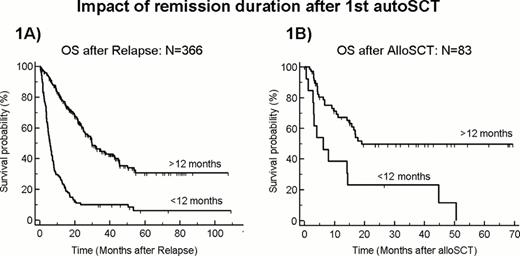Abstract
Abstract 474
Autologous stem cell transplantation (autoSCT) is considered as standard treatment for non-frail patients with mantle cell lymphoma (MCL). However, little is known about outcome of MCL recurrence after autoSCT. We therefore conducted a retrospective analysis of patients with MCL who failed autoSCT using the EBMT database.
PRIMARY OBJECTIVE was to analyse outcome and prognostic factors after relapse following autoSCT for MCL in the rituximab era.
PRIMARY ENDPOINT was overall survival (OS) from relapse.
ELIGIBLE were patients aged 18 years or more who relapsed following an autoSCT for MCL performed between 2000 and 2010 and who were registered with the EBMT. Centres were contacted to provide additional information on relapse treatment.
STATISTICAL ANALYSIS was based on log-rank comparisons and multivariable testing using Cox regression models.
1054 patients meeting the eligibility criteria could be identified in the EBMT registry. Of these, a full data set could be retrieved for 382 patients. Sixteen patients had to be excluded due to loss of follow up (n=7), wrong diagnosis (n=6), or falsely reported relapse (n=3). Median age at autoSCT of 366 evaluable patients was 59 years (range: 37 to 76), 290 patients (79%) were men. 64% had undergone autoSCT as part of 1st-line therapy; 68% and 49% had documented exposure to rituximab (RTX) and high-dose ara-C (HA) before autoSCT; and 12% had had refractory disease at autoSCT. Median time from autoSCT to relapse was 20 months (range: 0.4 to 117). 21 relapses (6%) occurred beyond 5 years after autoSCT.
With a median observation time of 37 months (95% CI 32–43), median OS after relapse of the whole study group was 20 months. By univariate analysis, a long (>12mo) interval between autoSCT and relapse (p<0.001; HR 0.26; Figure 1A), 1st-line autoSCT (p=0.006; HR 0.7) refractory disease at autoSCT (p<0.001, HR 2.0) and more recent year of relapse (p<0.001, HR per year 0.9) significantly influenced OS from relapse, whereas age, gender, RTX and HA exposure did not. By multivariate analysis refractory disease at autoSCT (p<0.001, HR=2.14), remission duration after autoSCT (p<0.001 HR per 3 months 0.88) and calendar year of relapse (p<0.03, HR per year 0.93) were confirmed to be predictors for OS. In addition, HA exposure prior autoSCT adversely affected OS from relapse (p=0.06, HR 1.38).
Salvage chemotherapy after relapse resulted in only 31% complete responses and 29% partial responses, whereas 40% of patients have been refractory to first salvage chemotherapy. 83 patients (23%) received an allogeneic SCT (alloSCT), whereas only 7 patients (2%) received a second autoSCT after relapse. Median time after relapse to second SCT was 7 months (range: 1 to 40). Survival after relapse for patients who received a second autoSCT was poor with no long-term survivor. AlloSCT performed for late relapse (>12mo) after autoSCT was associated with superior OS compared to patients who received an allograft upon a shorter remission duration after autoSCT (5-year OS from alloSCT 50% vs 0%; p=0.001; Figure 1B). Achievement of CR before alloSCT (p=0.05 HR=0.5), but not donor source, T-cell depletion or conditioning intensity affected OS after alloSCT.
Patients with MCL who relapse within one year after autoSCT have an extremely dismal outcome even with alloSCT. In contrast, about half of the patients who have MCL recurrence beyond one year after autoSCT and can undergo salvage alloSCT enjoy long-term survival. It remains to be shown if a similarly good outcome can be achieved without alloSCT in this favourable selection of patients. A 2nd autoSCT does not appear to be a promising option in patients with MCL failing a 1st autoSCT.
Walewski:Mundipharma: Honoraria, Membership on an entity's Board of Directors or advisory committees, Research Funding, Speakers Bureau; Roche: Honoraria, Speakers Bureau; GSK: Membership on an entity's Board of Directors or advisory committees; Celgene: Membership on an entity's Board of Directors or advisory committees; Janssen-Cilag: Membership on an entity's Board of Directors or advisory committees; Cephalon: Research Funding.
Author notes
Asterisk with author names denotes non-ASH members.


This feature is available to Subscribers Only
Sign In or Create an Account Close Modal